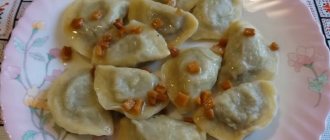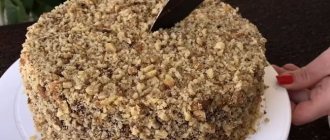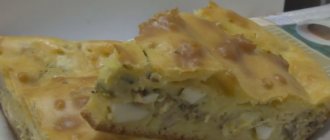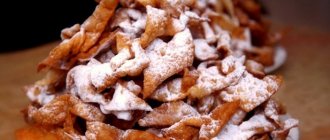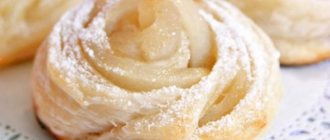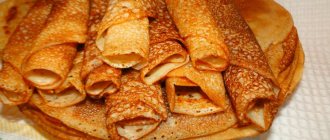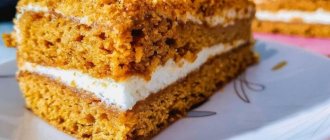1 kg
20 minutes
118 kcal
5/5 (1)
- Ingredients
Pelmeni is an original Russian dish that has become quite popular in the CIS countries. How often have you caught yourself thinking that it would be very nice to try such a seemingly simple, but so satisfying and tasty dish for dinner today?
If this thought comes to you quite often, but you don’t want to overpay for low-quality and tasteless semi-finished products, then this means only one thing - it’s time to learn how to cook dumplings yourself. The success of this dish lies not only in tasty minced meat, but also in properly prepared dough, which should not break during the cooking process. It is at the stage of preparing the dough that we will focus our attention today.
Let's find out how to properly make dough for dumplings.
The best yeast dough for pies
Yeast dough is officially recognized as the most suitable and tasty, which is explained by its versatility. This dough is suitable for both sweet and savory pies; it remains soft for a long time and does not go stale; many people even make pizza with this dough.
Any yeast, dry or fresh, is suitable for its preparation, but you need to store it in the refrigerator so that it retains its properties longer.
There is nothing wrong with yeast-free dough, but it is less fluffy and goes stale faster, making it difficult to enjoy the multifaceted and unique taste of homemade pies.
In the event that you have never dealt with dough, you should try using yeast dough, who knows, maybe luck will smile on you right away? Housewives know that pies can save any feast, even if it is unplanned. Yeast dough is best suited; the experience of generations and recipes passed down from mother to daughter are further proof of this.
Yeast dough recipe
For the perfect test you will need:
- Half a liter of warm milk, kefir, fermented baked milk, etc.
- A packet of dry yeast, replaced with 30 g of fresh yeast.
- 2 tablespoons sugar.
- One and a half teaspoons of salt.
- 800-1000 g flour.
- About 90 ml. vegetable oil.
Preparation
In a large ceramic container, mix milk or kefir and water, which must first be heated in a water bath. If there are no fermented milk products in the house or someone in the household suffers from a dairy allergy, use regular boiled water.
An important point: the liquid must be warm, no higher than 35C, otherwise the dough will be spoiled.
Then you need to lay out or pour out the yeast and stir thoroughly until it is completely dissolved. Now it’s time for sugar and salt, pour them into the resulting mass and stir until completely dissolved.
Sugar will not dissolve in cold water or liquid, which is why it needs to be heated. Make sure that the yeast dissolves without lumps; they will not spoil the dough, but will affect the taste and fluffiness.
Now it’s the turn of flour, you can take not the most expensive, wheat flour. First sift it through a fine sieve, this is necessary so that more air gets into the flour, so the dough will be soft and airy.
Slowly pour a couple of glasses of flour into the prepared mass, stirring continuously. It is impossible to calculate the amount of flour in grams; a lot depends on the type, grinding and density of the flour. Mix thoroughly so that there are no lumps left, otherwise the pies will be tasteless.
The most important rule: no eggs, in any form! Eggs and sour cream are needed for the butter dough from which buns are baked; it is not suitable for pies.
Do not pour both glasses of flour into the container, there may be too much of it, it will be difficult to correct the situation, but you can add flour at any time, do not rush.
After the dough is kneaded, add butter and add flour if necessary. Clarification for those who are watching their figure: the pies will not turn out too greasy, the oil will not be felt at all, but when modeling, the dough will not stick to your hands, which will greatly facilitate your task.
Almost on-topic article: Sweet fruit pizza - recipes and step-by-step preparation.
The correct yeast dough for pies is elastic, soft and springy. If the volume of text increases before your eyes, you are working in the right direction; the yeast is raising the dough.
If the dough still sticks to your hands, you need to add a little more flour; as soon as the dough reaches the correct condition, it will stop sticking and it will be easier to work with.
Dense and hard dough is suitable for khinkali and dumplings, but not for flavored pies.
If there is not an ounce of yeast in the house, but you still want to make pies, you can knead the usual place. Fry in a frying pan in butter, but the dough should be as thin as possible. This way it will cook better.
Let's get to the main thing
The yeast dough for pies is finished, you can start the most important thing, modeling and filling. To make it rise, cover the container with the dough with a thin waffle towel or cling film and leave for a couple of hours.
The choice of filling is yours, based on your taste preferences.
Yeast dough for pie in the oven: recipe with photo
Today we will tell you how to properly prepare yeast dough at home.
There is probably no person in the world who would not like fragrant, freshly baked pies. They can be with cherries or potatoes, with plums or cabbage. But it’s not the filling that determines the quality of the baked goods, but the correct kneading and adherence to the recipe. If you prepare yeast dough for pies in the oven at least once, a step-by-step recipe with a photo of which is presented below, you will never want to return to the previous kneading methods.
Ingredients (for 36 pieces):
- wheat flour - 1 kg;
- fresh milk - 0.5 l.;
- fresh yeast - 60 gr. (or 20 grams dry);
- butter - 200 gr.;
- eggs - 4 pcs. (+ 1 yolk);
- vegetable oil - 6 tbsp. l. ;
- sugar - 90 gr.;
- salt - 2 tsp;
- filling as desired.
See also: Jellied pie with apples: a quick recipe
Step-by-step preparation:
Step 1 . Pour the heated milk into a deep container and add yeast to it. Gradually stirring the mixture, add a glass of flour and 15 g of sugar. For the dough to fit well, it must be placed in a warm place for about 30 minutes, after covering the container with a clean towel.
Step 2. When the dough is ready, add salt, the remaining sugar and 4 beaten eggs. It is important that the eggs are pre-warmed to room temperature: otherwise the reaction will be much slower and the dough will not rise well.
Step 3. Melt the butter in the microwave or in a steam bath and add it to the dough. It is important that the oil is warm, but not hot, otherwise the high temperature will kill the yeast and the pies will not be airy and fluffy. We also pour vegetable oil there.
Step 4. Mix the resulting mixture well and begin to gradually add flour to it. This amount of ingredients takes up to a kilogram of flour, but do not overfill the dough. It should turn out uncool, but at the same time not stick to your hands.
Step 5. Do not neglect the process of intervention. The more time devoted to this stage, the more airy and soft the dough will be.
Step 6. Divide the finished dough into two parts, after which we cut each of them into small pieces. They are so soft that you don’t even need to use a rolling pin to form the pies; everything can be easily pulled out by hand.
Now all that remains is to add the filling to taste, let the pies rise without the oven for 20-25 minutes, and you can bake your beauties. Before baking, brush them with egg yolk to give them a nice brown color. Baking time depends on the mode and condition of the oven. The pies turn out very brown and crispy.
Bon appetit!
Fried and baked yeast pies
The taste of the pies depends on the cooking method; for those who are watching their weight and figure, it is better to eat pies cooked in the oven; they have fewer calories, since almost no oil is used in the baking process. Fried pies are also incredibly tasty; it is recommended to cook them in a frying pan. Fillings may vary.
Fillings for pies made from yeast dough
- Stewed cabbage with herbs, tomato paste and carrots. You can add bacon, sausages, eggs and even prunes to taste.
- Sauerkraut, add lingonberries for piquancy.
- Minced chicken, pork, beef, add fried onions, cheese, eggs. It's nourishing, tasty and high in calories, so be careful.
- Mushrooms, add onions, potatoes or cabbage; mushrooms can be combined with any vegetables.
- Liver with fried onions. Inexpensive, accessible and very tasty.
- Boiled eggs with green onions and mushrooms, classic.
- Boiled rice, millet, buckwheat. You can add greens, fried champignons, cheese and even fish to the cereal.
- Boiled potatoes with onion cracklings, champignons or ham.
- Peas are a bit risky given the specific side effects of legumes.
- It is better to use boiled or canned fish, with the addition of onions, sour cream and herbs.
- Cheese with green onions, dill and ham (can be replaced with sausage or sausages). It's best to eat hot while the cheese is soft and stretchy.
- Spinach is an option for those who adhere to proper nutrition and watch their figure. Can be mixed with cottage cheese or mozzarella, delicate taste.
- Beans are just as dangerous a filling as peas. Too tasty to deny yourself the pleasure.
- Tomatoes with cheese and herbs. This combination is suitable not only for pizza, it is tender, tasty and very appetizing.
The main thing is not to be afraid and not to give up, even if not everything works out the first time. Water wears away stones, and the seas are conquered only by the brave, stubborn and courageous.
If you have once again put off making delicious pies, but came across this article, consider it a sign from above! There is no shame in asking for advice or having doubts. There is a wonderful proverb “the first pancake is lumpy”; it can be applied everywhere, and in this case.
Step-by-step recipe for delicious, soft and elastic dough for homemade dumplings
This recipe for dumpling dough is the simplest and most classic; the dough will be cooked in water.
Kitchen utensils: sieve, bowl, glass.
Ingredients
| Premium flour | 4 stacks |
| Chicken eggs | 2 pcs. |
| Water | 1 stack |
| Salt | 1 tsp. |
How to make dumpling dough
- Add a teaspoon of salt to one glass of water at room temperature (a small heap is possible) and stir it in the water, then wait until it is completely dissolved.
- Sift four cups of flour through a sieve directly into a bowl. It is important to consider that the glasses for flour and water should be the same size, since this is very important for us. Roughly speaking, for the dough we need four parts flour and one part water.
- The flour is sifted, so it is saturated with oxygen, after which it will become much more pliable for making dough from it, and this will also be reflected in the finished dough. Take about half a glass of flour from the bowl. By this time, the salt in the water will completely dissolve. Pour the water into the hole formed in the flour.
- We knock out two chicken eggs there.
- Using a tablespoon, start kneading the dough. As soon as it begins to form, you can start kneading with your hands until there is no flour left in the bowl. From the glass we pour out the flour that we recently took from the bowl onto the table and put our dough out of the bowl onto it.
How to knead dough for dumplings? This should be done directly on the flour, as if pressing it into the dough. It is advisable to knead it for about 5 minutes, after which it should be covered with a bowl and left to rest for 5-10 minutes, after which it will become more amenable to cooking.
- After the dough has rested, mix in the remaining flour on the table. This will take about five more minutes, knead the dough until there is no flour left on the table.
- After thorough kneading, our dumpling dough is completely ready. All that remains is to prepare the filling and boil this wonderful dish. If you want to save this dough for later, then do not forget to place it in a plastic bag so that it does not dry out.
Video recipe for preparing dough for dumplings using water
If you still have any questions about preparing dough for dumplings, be sure to check out this video recipe. It describes all stages of preparation in as detailed and clear a manner as possible. Remember, good dumplings are not only tasty filling, but also soft dough that will not break during cooking.
